LoRa experiments in the 70 cm band
 .
.
Some time ago I ordered some radio modules with the SX1276 chip for experimentation. After some time, I finally decided to get around to testing them.
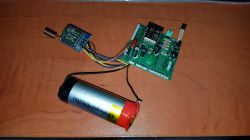
In order to make a sensible estimate of the range and capabilities of these modules, I built several devices: two serving as receivers/transmitters and three transmitters. I programmed all the devices myself from scratch, avoiding off-the-shelf solutions such as Meshtastic.
The receiving part
 .
.
The receiving part consists of an SX1276 chip connected to an ESP32 on a WT32-ETH01 module and a DC/DC converter powering the whole thing from a 24V passive PoE adapter. The software receives and decodes the signal and then transmits it to the server, creating something like a 'LoRa gateway'. I have built two such gateways: one is connected to a Diamond X30 vertical antenna and the other to an ATK-5 dipole antenna in horizontal polarisation. Both antennas are mounted on a 55-metre stadium light pole, although the location is not ideal as it is at the lowest part of town, right next to the lake. I used about 2 metres of H155 cable at the antennas. In addition to receiving data from the ether, the software on the 'gateway' also allows transmitting and changing the radio configuration. In addition, it has a simple web interface for monitoring the status of the device.
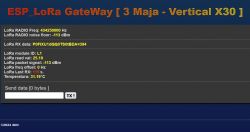 .
.

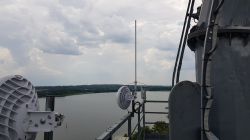 .
.
Transmitters
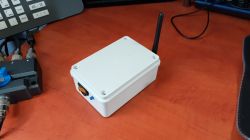
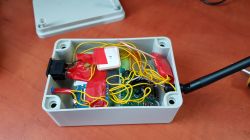
The first transceiver created to estimate the potential was a locator built with ESP8266, SX1276 and NEO6P GPS module. The software in this device first waits for a GPS signal and then formats it into a string such as: "51.16960*69.95865*0" (position and speed). The entire string is encoded with the XOR function, a checksum calculated from the ASCII codes of the entire string is added, and then the whole thing is sent over the radio. Depending on the speed read from the GPS, the device goes to sleep for a certain amount of time. If the speed exceeds 30 km/h, the device does not go to sleep, but sends a position every 5 seconds. The time it takes to send such a string depends on the radio's configuration. I placed the whole thing in an electrical box, which, although it does not look aesthetically pleasing, works properly. The device powered by three 18650 cells works for 4 days. The first tests showed the great potential of this solution, as illustrated by the attached range map.
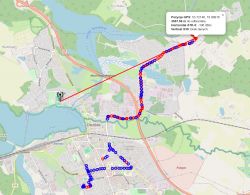
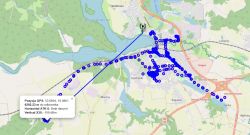
After determining the range, I built another transmitter with ESP8266, SX1276 and DS18B20 sensor, placing it in an airtight box along with two 3.6V 17Ah lithium batteries. The device only reads the temperature from the DS18B20 sensor, formatting it in string: "L01|25.5|3.567" (ID + temperature reading + battery level), then encrypts and adds a checksum similar to the locator. I installed the device at a distance of 6.5 km from the receiver, in the middle of a forest near Ostróda, attached to a tree. The antenna at the transmitters is an ordinary 'stick' bought for £20. Experiments with a wire dipole gave similar results.
 .
.
I am very pleased with the results - using a simple method, I have achieved 'telemetry' with a range of practically the entire city, and at distances of up to 2 km, the signal even reaches the basements of buildings. This opens up the possibility of building an energy-efficient burglary radio system without subscriptions or other charges.
In addition, I am measuring the radio background on the frequency 434.250 MHz, on which I am currently experimenting. I am attaching the temperature transmitter code, maybe someone will have interesting suggestions.
 .
.
Well and a temperature measurement from the forest




Comments
Thanks for sharing your experiments! My modules are still lying ;) . I didn't expect such ranges. Text me a Parcel Post and I'll send a little gift! :) [Read more]
Remember the legally permissible bandwidth occupancy rate. Long range is achieved at the expense of low bandwidth. That is, transmitting a frame requires the transmitter to be on for quite a long time. You... [Read more]
Very interesting experiments, what is the purpose of xorating the coordinates? [Read more]
What are the purse links in the photo? [Read more]
Yes, I know about this. With current radio settings it takes about 0.6 sec to send 30 bytes. Basically none, I experimented and forgot about it and it stayed that way ;) Lithium batteries (not... [Read more]
Is it worth using these instead of rechargeable batteries e.g. 18650? As I look the price of these batteries is around 70£ per cell. [Read more]
Yes, 17 Ah would be about 6 18650s, and here I have the same in R20 battery volume - plus no problem in sub-zero temperatures. The sensor draws 39 μA when asleep, 130 mA when transmitting and lasts 0.4s.... [Read more]
"Energy density" is sizable, similar ones are found in disposable ten-year-old CO sensors, and were once used in electromechanical timers that controlled dual-rate electricity meters. When photography... [Read more]
What could be the real delays in open space and 500m distance? Do you have any idea how to estimate such a thing to know exactly how much the transmission was? [Read more]
. Signal propagation over this distance is approximately 16 nS. [Read more]
Packet transmission is quite slow at high SF values, so the method of modulation will affect the time from preparation of the data for sending, to the appearance of the data in the receiver buffer. This... [Read more]
And it doesn't interfere with the cranes because they like that 434.25MHz I think it was CH41 on the radios. [Read more]
If I was transmitting something from where I have these receivers - on that high object then maybe I would be interfering with something. But there is only a receiver there. The transmitter is currently... [Read more]
LoRa is a wideband modulation that is immune to interference. However, a signal with such modulation increases the noise floor on many channels. For this reason, special regulations for the use of such... [Read more]
. A little off-topic: I see a link from a disposable e-cigarette ;) I once spotted a commercial, with used disposable e-cigarettes in the electro-junk in a ladybird shop and took them in. As... [Read more]
@dktr what do the red and blue circles on the map mean? What kind of map are you using? I used to train geoportal for a similar game. @error105 I don't know exactly how much you need, but you could... [Read more]
The colour of the dots indicates which receiver received the signal, blue dot both receivers, red dot one receiver. I always use openstreetmap because it has a nice api and you can se locally host everything... [Read more]
What are these cells and what do you charge them with? [Read more]
. Cells, like cells. They have a high discharge current. I don't know about the durability. And I charge them with a CC/CV power supply. [Read more]